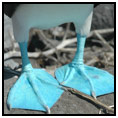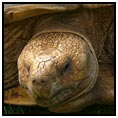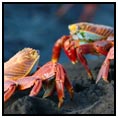Categories
To determine which month to make this trip, here’s a “nesting calendar. Their rainy season consists of “perhaps” an hour of rain a day; otherwise it’s a dry, arid region where cacti can grow.



January
Beginning of the rainy season. Land birds start nesting, generally after the first rain. On Española the adult male marine iguanas become brightly colored. The green sea turtle arrives to the beaches of Galapagos to lay their eggs. Land iguanas begin reproductive cycles on Isabela. Both, water and air temperatures rise and stay warm until June. Ideal time for snorkeling.
February
On Floreana flamingos start nesting. Bahamas pintails start their breeding season. Masked boobies on Española are at the end of their nesting season. Marine iguanas nest on Santa Cruz.
The highest water temperature reaches 25°C (77°F). This temperature remains until April. Very few penguins are sighted in Bartholomew. The nesting season of the Galapagos dove reaches its peak.
March
The rainy season reaches the highest precipitation. Sporadic tropical rains, intense sun and hot climate. Air temperature can reach up to 30°C (86°F) Marine iguanas nest in Fernandina.
March 21, the beginning of the summer equinox signals the arrival of the waved albatross to Española.
April
Massive arrival of waved albatross to Española. Their courtship starts. End of hatching season of the giant tortoises. The eggs of the green sea turtles begin to hatch. Land iguanas hatch on Isabela.
May
North Seymour's blue footed boobies begin their courtship. Sea turtles are still hatching on GardnerBay, Punta Cormorant and Puerto Egas. Most of the marine iguanas eggs hatch from nests on Santa Cruz. Palo santo trees begin to shed their foliage. Albatross on Española start laying their eggs. Band- rumped storm petrels begin their first nesting period.
June
Begining of the garúa season. Giant tortoises on Sta. Cruz migrate from the highlands to the lowlands in search of suitable nesting places. Beginning of the nesting season of giant tortoises.
July
Sea bird communities are very active, especially the blue footed boobies on Española. Flightless cormorants court and nest on Fernandina. It is possible to find oyster catchers nesting on Puerto Egas. Lava lizards initiate mating rituals until November. Whales are more likely to be observed, especially off the Western coast of Isabela.
August
The Galapagos hawks court on Española and Santiago. Mask boobies and swallow-tailed gulls nest on Genovesa. The temperature of the ocean descends to 18° C (64°F), which obviously varies according to the geographic zones among the islands. Migrant shore birds start to arrive, and stay on the islands until March. Giant tortoises return to the
highlands of Santa Cruz.
September
The peak of the cold (garúa) season. The air temperature reaches its lowest (19° C) (66°F). Penguins demonstrate remarkable activity on Bartolomé until December. Sea lions are very active, especially in the western and central areas of the Archipelago. Most species of marine birds remain active at their nesting sites.
October
Lava herons nest until March. The Galapagos fur seals begin their mating period. Boobies raise their chicks on Española. Giant tortoises still lay their eggs.
November
Sea lion pups are born. Sea lions are sexually active on the Eastern part of the Archipelago. Breeding season of brown noddies Band-rumped storm petrels begin their second nesting period.
December
Hatching of the giant tortoise's eggs begins and lasts until April. Green sea turtles display their mating behavior. The rainy season begins, all of the plants of the dry zone produce
leaves. Galapagos "turns green". The first young albatross fledge.
NOTE: Due to changes in the strength and the limits of the ocean currents that can affect the weather in
Galapagos, some of the events described above may differ.
The ship goes to 2 ports per day. 2-3 excursions are offered in each port (mild, moderate & intense). “Mild” is getting on a small boat (the Zodiac) that takes you around. You get to choose which excursions you want. The ship is like a large yacht. It has your dining rooms, grille, small spa, hot tub, bars/lounges and the cabins. There are no casinos, Broadway-type shows. Cruise fare includes all the excursions (approx 21 excursions), gratuities, port charges & taxes, 6 naturalists, beverages and some alcoholic drinks (not premium drinks), snorkels & wet suits. Does not include massages, souvenirs, laundry (dry cleaning not avail) or drinks on shore.
Celebrity Xpedition Cruisetour includes all of the above, plus hotel, meals & beverages at the hotel, pickup at Quito, Ecuador, transfers to Baltra, Galapagos and back to Quito. A typical 10 night cruisetour consists of 2 nights at hotel, 7 nights on the Xpedition, 1 night hotel.




